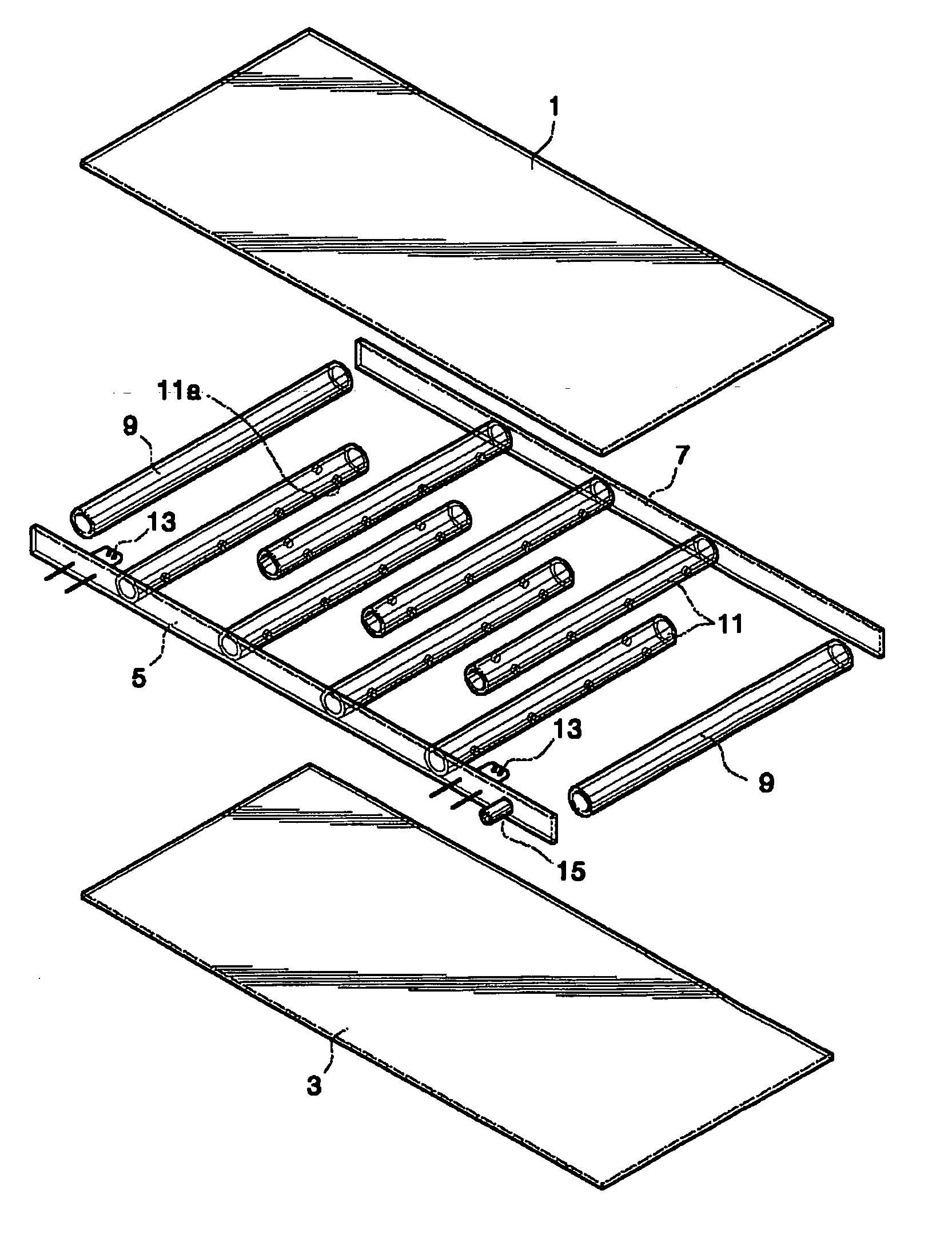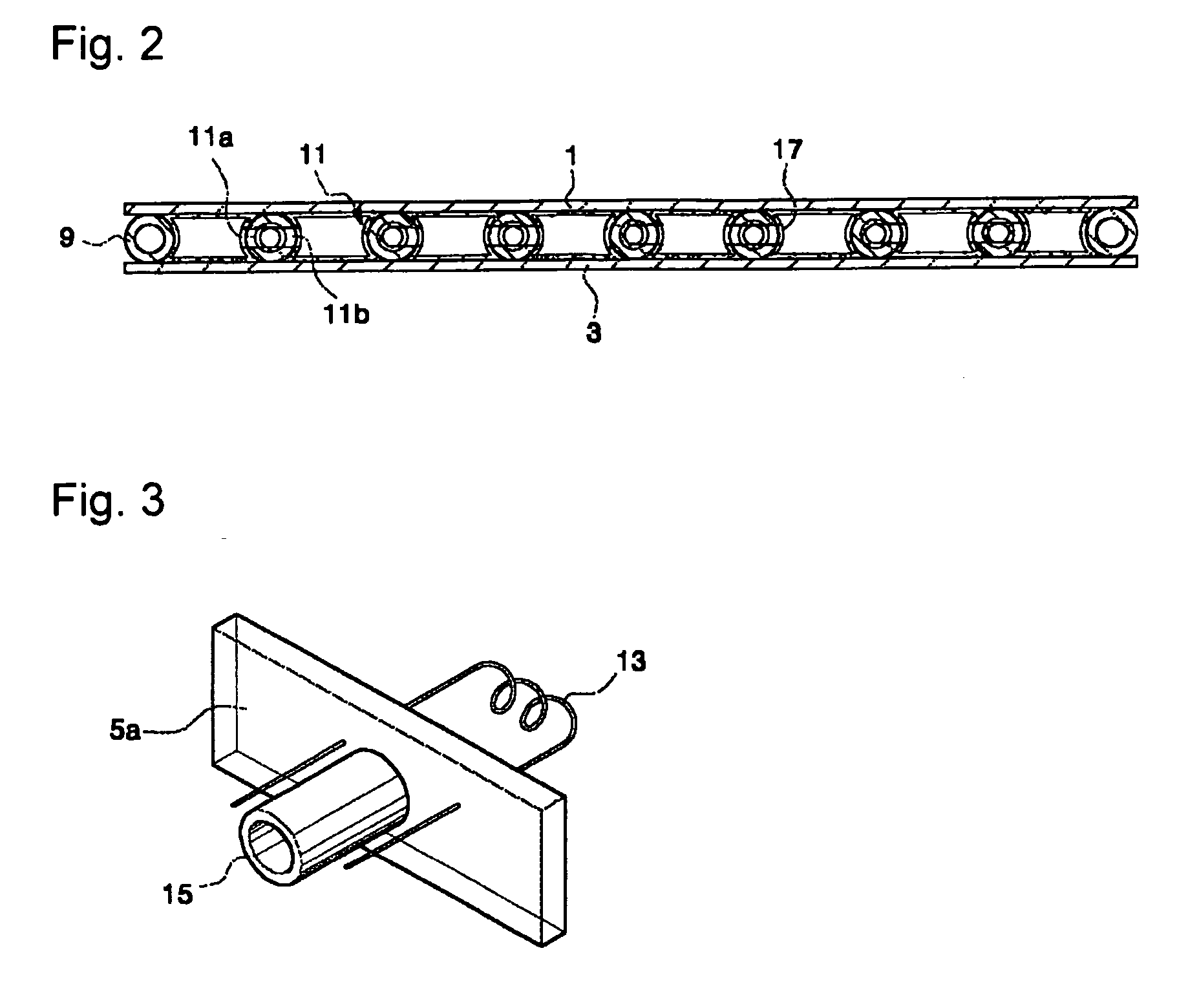Flat type fluorescent lamp
a fluorescent lamp and flat-type technology, applied in the field of flat-type fluorescent lamps, can solve the problems of limited inability to achieve constant light emission and brightness on the whole surface, and inability to reduce the thickness of plate-type spacers, so as to improve light emission efficiency and brightness, remove non-light emission areas, and expand light emission areas
- Summary
- Abstract
- Description
- Claims
- Application Information
AI Technical Summary
Benefits of technology
Problems solved by technology
Method used
Image
Examples
embodiment 1
[0037]FIGS. 1 and 2 show a flat type fluorescent lamp according to a first embodiment of the present invention.
[0038] As shown in the drawings, the inventive flat type fluorescent lamp is defined by a rectangular parallelepiped outer lamp body for realizing a surface light source such as a backlight for a flat display and a lighting device.
[0039] The outer lamp body comprises front and rear panels 1 and 3, and longitudinal and lateral seal members 5, 7, and 9 for sealing a space defined between the front and rear substrates 1 and 3. Here, the rear panel 3 and the seal members 5, 7 and 9 are formed of transparent or semi-transparent material. Moreover, a reflection layer may be formed on the rear panel 3.
[0040] In addition, the lateral seal members 9 may be formed of tube spacers. Each of the tube spacers 9 has a length identical to that of a width of the outer lamp body. The longitudinal seal members 5 and 7 may be formed of side plates.
[0041] As a feature of the invention, plur...
embodiment 2
[0060]FIGS. 6 and 7 show a flat type fluorescent lamp according to a second embodiment of the present invention.
[0061] As shown in the drawings, the inventive flat type fluorescent lamp of this embodiment includes an outer lamp body as in the first embodiment. As a feature of this embodiment, plural tube spacers 111 are disposed between the front and rear panels 1 and 3.
[0062] Each of the tube spacers 111 is designed shorter than the width of the outer lamp body. That is, the length of the tube spacer 11 is {fraction (1 / 10)}-½ of the width of the outer lamp body. The tube spacers 111 can be randomly disposed or aligned in lines. As in the first embodiment, a section of the tube spacer 111 can be designed in a variety of shapes such as a circular-shape, an oval-shape, or a polygonal-shape.
[0063] The above described structure and arrangement of the tube spacers 111 according to this embodiment allows the phosphor layer 17 to be more easily deposited to an inner surface of the outer...
embodiment 3
[0066] This third embodiment is identical to the first and second embodiment except that a phosphor layer 17 is further optimized to improve the light emission efficiency and the brightness.
[0067] That is, in this third embodiment, a thickness “d” of the phosphor layer 17 deposited on the inner surface of the outer lamp body is defined to satisfy the following range:
d=4logeW˜d=4logeW+16
where, W indicates electric power of the lamp.
[0068] Test results obtained by the above conditions are shown in Table 1 and FIG. 9. In the test, a three-wavelength phosphor is used as the phosphor material, and Y2O3:Eu, LaPO4:Ce,Tb, and (Sr,Ca,Ba)10(PO4)6C12:Eu are respectively used for red R, green G and blue B colors of the phosphor material. In addition, the phosphor has a mean particle size in a range of 2-10 μm and is deposited on 80±10% with respect to the entire surface area.
[0069] Alternatively, phosphor material used for a plasma display panel (PDP) can also be used as the phosphor. The...
PUM
 Login to View More
Login to View More Abstract
Description
Claims
Application Information
 Login to View More
Login to View More - Generate Ideas
- Intellectual Property
- Life Sciences
- Materials
- Tech Scout
- Unparalleled Data Quality
- Higher Quality Content
- 60% Fewer Hallucinations
Browse by: Latest US Patents, China's latest patents, Technical Efficacy Thesaurus, Application Domain, Technology Topic, Popular Technical Reports.
© 2025 PatSnap. All rights reserved.Legal|Privacy policy|Modern Slavery Act Transparency Statement|Sitemap|About US| Contact US: help@patsnap.com



